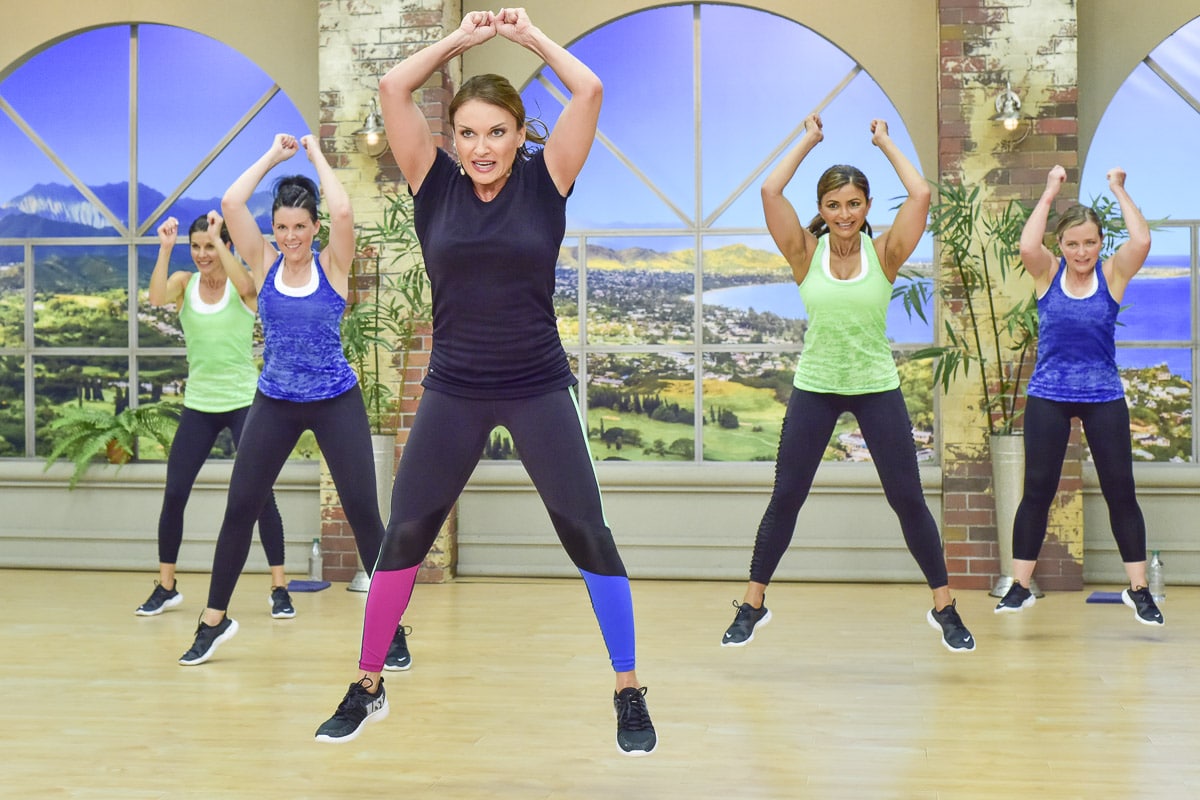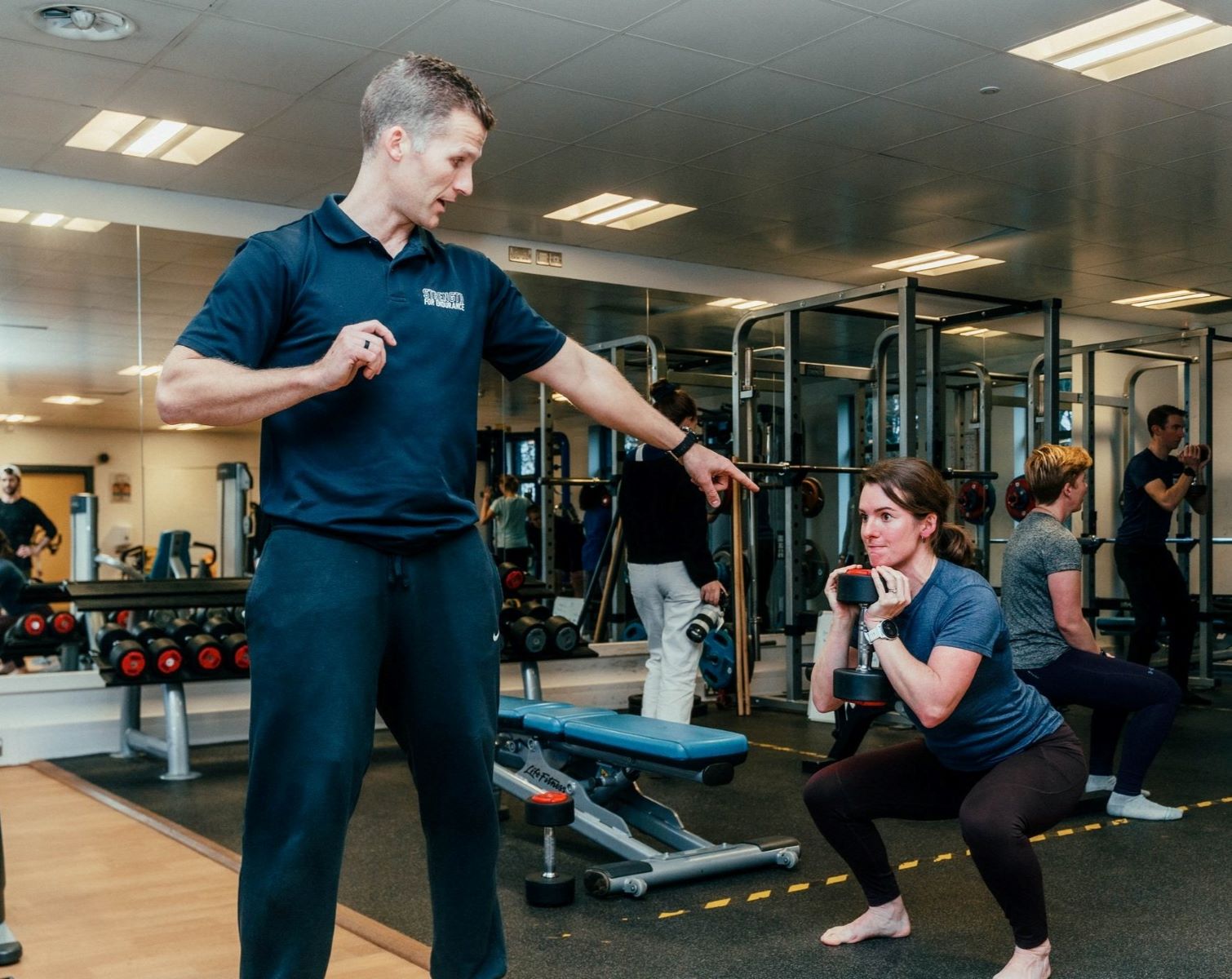Home>Misc>Featured>Which Of The Following Training Variables Impact High Intensity Interval Training


Featured
Which Of The Following Training Variables Impact High Intensity Interval Training
Modified: March 2, 2024
Find out how the featured training variables affect high intensity interval training and optimize your workouts for better results.
Introduction
High Intensity Interval Training (HIIT) has gained significant attention in the fitness industry for its ability to deliver maximum results in a short amount of time. With its combination of intense exercise and brief recovery periods, HIIT has proven to be an effective method for improving cardiovascular fitness, burning calories, and increasing muscle strength.
However, the success of HIIT is not solely dependent on the exercises performed or the duration of the workout. The training variables utilized in HIIT play a crucial role in determining its effectiveness and impact on the body. By manipulating and optimizing these variables, individuals can tailor their HIIT workouts to meet their specific fitness goals.
In this article, we will explore the key training variables that impact HIIT and delve into their significance in designing an effective workout program. From the duration of work and rest intervals to the intensity level, exercise selection, and frequency of training sessions, we will examine each variable and its influence on the efficacy of HIIT.
Whether you are a fitness enthusiast looking to enhance your HIIT routine or a trainer seeking to maximize the benefits for your clients, understanding these training variables is essential for achieving optimal results.
So, let’s dive into the world of HIIT and uncover the training variables that hold the key to an effective and impactful workout regimen.
Definition of High Intensity Interval Training (HIIT)
High Intensity Interval Training, commonly known as HIIT, is a training method that involves alternating between short, intense bursts of exercise and brief recovery periods. This type of workout is characterized by its high intensity and efficiency, making it a popular choice for individuals looking to maximize their fitness gains in a limited amount of time.
The structure of HIIT involves pushing your body to its maximum effort during the intense intervals, followed by a short period of active recovery or complete rest. The intervals can range from as short as 20 seconds to as long as 2 minutes, depending on your fitness level and goals. HIIT can be performed with a variety of exercises, such as running, cycling, bodyweight exercises, or even using equipment like kettlebells or resistance bands.
What sets HIIT apart from traditional steady-state cardio exercises is its ability to elevate your heart rate significantly and keep it elevated even during the recovery periods. This constant fluctuation in intensity challenges your body’s energy systems, including the aerobic and anaerobic pathways, leading to improved cardiovascular fitness and endurance.
One of the key benefits of HIIT is its efficiency in burning calories and fat. Research has shown that HIIT can increase your post-workout calorie burn, known as the afterburn effect or excess post-exercise oxygen consumption (EPOC). This means that even after you’ve completed your HIIT workout, your body continues to burn calories at a higher rate compared to traditional steady-state cardio.
Another advantage of HIIT is its potential to preserve muscle mass while promoting fat loss. Since HIIT utilizes short, intense bursts of exercise followed by recovery periods, it stimulates the production of growth hormone, which helps to maintain and build muscle tissue. This makes HIIT an ideal choice for individuals looking to improve their body composition and achieve a leaner physique.
Overall, HIIT is a versatile and effective training method that can be adapted to various fitness levels and goals. Whether you’re a beginner looking to improve your cardiovascular fitness or an athlete aiming to enhance your performance, incorporating HIIT into your routine can help you achieve your desired results in a time-efficient manner.
Importance of Training Variables in HIIT
When it comes to High Intensity Interval Training (HIIT), the training variables play a crucial role in determining the effectiveness and impact of the workout. These variables include the duration of work and rest intervals, intensity level, exercise selection, frequency of training sessions, volume of work, and recovery periods. Each of these variables can be adjusted and manipulated to create a customized HIIT program that aligns with an individual’s fitness goals and capabilities.
Firstly, the duration of work and rest intervals is a key training variable in HIIT. The length of these intervals can significantly impact the level of intensity and the metabolic response of the body. Shorter work intervals with equally short rest intervals create a more intense workout, challenging the cardiovascular system and promoting fat burn. On the other hand, longer intervals allow for higher intensity efforts and can target different energy systems. Finding the right balance of work and rest intervals is important for achieving the desired training effect.
The intensity level is another critical variable in HIIT. The high-intensity efforts during the work intervals are what make HIIT so effective. By pushing the body to its maximum exertion, individuals can stimulate improvements in aerobic and anaerobic fitness. However, it’s essential to consider individual fitness levels and gradually increase the intensity over time to prevent injury and ensure sustainable progress.
Exercise selection is also vital in HIIT to target specific muscle groups and energy systems. By incorporating a variety of exercises, individuals can enhance overall strength, enhance muscular endurance, and prevent boredom. Choosing exercises that are functional and compound in nature can optimize the effectiveness of HIIT workouts.
The frequency of training sessions is an important training variable in HIIT. While HIIT workouts are intense and demanding, it’s important not to overdo it. Allowing ample recovery time between sessions is crucial to prevent fatigue, overtraining, and injury. Finding the right balance between training and rest is key to achieving long-term progress and avoiding burnout.
The volume of work, or the total amount of exercises and repetitions performed during a HIIT workout, is another crucial training variable. Adjusting the volume can influence the overall workload and intensity of the session. Higher volume workouts can be more demanding and require longer recovery periods, while lower volume sessions can be more manageable for beginners or those with limited time.
Lastly, recovery periods between HIIT sessions are essential for allowing the body to adapt, repair, and grow stronger. Adequate rest periods help prevent overtraining and ensure that the body is ready for the next session. Listening to the body and prioritizing recovery is key in optimizing the benefits of HIIT.
Overall, understanding and manipulating these training variables can significantly impact the effectiveness and outcomes of HIIT workouts. By personalizing the variables to align with individual goals and fitness levels, individuals can optimize their training and achieve the desired results in a time-efficient manner.
Duration of Work and Rest Intervals
The duration of work and rest intervals is a critical training variable in High Intensity Interval Training (HIIT) that can greatly impact the effectiveness and outcomes of the workout. The length of these intervals determines the intensity of the exercise and the amount of time allotted for recovery.
Shorter work intervals paired with equally short rest intervals create a highly intense workout. For example, a common HIIT protocol is the Tabata method, which consists of 20 seconds of maximum effort exercise followed by 10 seconds of rest, repeated for a total of 4 minutes. This type of high-intensity interval challenges the cardiovascular system and stimulates the body to burn fat and increase aerobic capacity.
On the other hand, longer intervals provide an opportunity for individuals to perform higher intensity efforts during the work phase. For instance, a HIIT session may include 60 seconds of intense exercise followed by a 60-second rest interval. This longer work period allows for a higher Vo2 max (maximum oxygen uptake) stimulus and targets different energy systems within the body.
The ideal duration of work and rest intervals can vary depending on individual fitness levels, goals, and the specific exercise being performed. Beginners may start with shorter intervals to allow the body to adapt, while more advanced individuals may be able to handle longer intervals and perform at a higher intensity due to their increased fitness levels and conditioning.
It’s important to note that the duration of work and rest intervals can also be adjusted within a single workout to create variation and prevent adaptation. For example, a pyramid structure can be employed, where the work intervals gradually increase in duration and then decrease, followed by corresponding rest intervals. This type of variation keeps the body challenged and prevents plateauing.
In addition to individual customization, the duration of work and rest intervals may also be influenced by the specific goals of the HIIT workout. If the primary objective is fat loss, shorter work intervals with minimal rest intervals may be utilized to create a higher caloric expenditure and metabolic demand. Conversely, if the goal is to improve anaerobic performance or power output, longer work intervals with slightly longer rest intervals may be incorporated.
Ultimately, finding the optimal balance of work and rest intervals is essential for designing an effective HIIT workout. It’s important to consider individual fitness levels and goals, gradually increase the intensity over time, and allow for adequate recovery to prevent overtraining and injury. By manipulating the duration of work and rest intervals, individuals can tailor their HIIT workouts to maximize fat burn, improve cardiovascular fitness, and achieve their desired outcomes.
Intensity Level
The intensity level is a fundamental training variable in High Intensity Interval Training (HIIT) that greatly influences the effectiveness and benefits of the workout. The high-intensity efforts during the work intervals are what make HIIT so effective at improving cardiovascular fitness, burning calories, and building strength.
The intensity of a HIIT workout refers to the level of exertion and effort put into each exercise. This can be measured using various methods such as heart rate, perceived exertion, or the rate of perceived exertion (RPE) scale. It’s important to note that the intensity should be challenging and push individuals beyond their comfort zones, but it should also be within their capabilities and safe.
When designing a HIIT workout, it’s essential to consider individual fitness levels and gradually increase the intensity over time. Beginners may start with lower intensities to allow their bodies to adapt and improve cardiovascular fitness, while more advanced individuals may be able to sustain higher intensities due to their increased conditioning.
One effective way to gauge and manipulate the intensity level in HIIT is using the concept of maximum heart rate (MHR) or percentages of MHR. The aim is to reach a target heart rate zone during the work intervals to ensure sufficient cardiovascular stress and promote physiological adaptations. For example, a target heart rate of 80-90% of maximum can be used for individuals aiming to improve their aerobic capacity, while a target heart rate above 90% can be used for individuals focusing on anaerobic power.
In addition to heart rate, the perceived exertion during HIIT workouts is also vital in determining intensity. The Borg RPE scale, ranging from 6 to 20, provides a subjective measure of perceived effort, with 6 being no exertion and 20 being a maximal level of exertion. Individuals can use this scale to monitor their intensity level and ensure that they are working at the desired level of effort.
It’s important to note that the intensity level in HIIT is relative to the individual’s capabilities and should be adjusted accordingly. What may be considered a high intensity for one person may not be the same for another. Listening to the body and avoiding overexertion or excessive fatigue is crucial to prevent injury and ensure sustainable progress.
Furthermore, the intensity level should be periodically reassessed and adjusted as individuals become fitter and stronger. Increasing the intensity over time is important for continued adaptations and improvements in cardiovascular fitness and overall performance.
Overall, the intensity level is a key training variable in HIIT that determines the effectiveness and outcomes of the workout. By carefully manipulating and monitoring the intensity, individuals can challenge their bodies, improve cardiovascular fitness, and achieve their desired goals.
Exercise Selection
Exercise selection is a crucial training variable in High Intensity Interval Training (HIIT) that significantly impacts the effectiveness and overall experience of the workout. By choosing the right exercises, individuals can target specific muscle groups, enhance overall strength, improve muscular endurance, and prevent boredom.
One of the key principles of exercise selection in HIIT is to focus on functional movements. Functional exercises mimic movements that individuals perform in their daily lives or sports activities, making them more applicable to real-world situations. Examples of functional exercises include squats, lunges, push-ups, burpees, and kettlebell swings.
Incorporating compound exercises is another important aspect of exercise selection in HIIT. Compound exercises engage multiple muscle groups and joints, allowing for a more efficient and effective workout. These exercises not only maximize calorie burn and cardiovascular benefits but also promote overall strength and muscle development. Examples of compound exercises include squat to press, deadlifts, rows, and step-ups.
Variety is key in exercise selection to prevent boredom and keep the body challenged. Adding different exercises to the HIIT routine can provide new stimuli for the muscles and prevent the plateauing of results. This variety can be achieved by incorporating exercises from different categories, such as cardiovascular exercises (e.g., running, cycling), bodyweight exercises (e.g., push-ups, squats), or using equipment like kettlebells or resistance bands.
Individual preferences and goals should also be considered when selecting exercises for HIIT. If someone enjoys running or cycling, incorporating these activities into the HIIT routine can enhance enjoyment and motivation. Likewise, if individuals have specific goals such as improving upper body strength or core stability, selecting exercises that target those muscle groups will be beneficial.
Additionally, exercise modifications and progressions can be utilized to cater to different fitness levels and abilities. For beginners, starting with modified or easier versions of exercises allows for proper form and technique while gradually building strength and endurance. More advanced individuals can progress to more challenging variations of exercises, such as adding weights or increasing the range of motion.
Lastly, it’s important to listen to the body and choose exercises that are appropriate for any injuries or limitations. Consulting with a fitness professional or physical therapist can provide guidance on exercise selection and modifications to ensure safe and effective workouts.
By considering functional movements, incorporating compound exercises, adding variety, and aligning exercises with preferences and goals, individuals can create a well-rounded and engaging HIIT workout that targets all major muscle groups, enhances cardiovascular fitness, and provides optimal results.
Frequency of Training Sessions
The frequency of High Intensity Interval Training (HIIT) sessions is a crucial training variable that determines how often individuals should incorporate HIIT into their workout routine. Finding the right balance between training and rest is key to achieving optimal results and preventing overtraining.
When considering the frequency of HIIT sessions, it’s important to factor in individual fitness levels, goals, and recovery ability. HIIT workouts are intense and physically demanding, requiring ample recovery time between sessions. Overtraining, which occurs when the body is not given enough time to recover and adapt, can lead to decreased performance, increased risk of injury, and mental fatigue.
For beginners or individuals new to HIIT, starting with 1 to 2 sessions per week is recommended. This allows the body to adapt and gradually build cardiovascular fitness and muscular endurance. As individuals progress and become more comfortable with HIIT, they can gradually increase the frequency of sessions to 3 to 4 times per week.
However, it’s important to listen to the body and be aware of signs of overtraining. If experiencing excessive fatigue, difficulty in recovering between workouts, persistent muscle soreness, or a decline in performance, it may be an indication that the frequency of HIIT sessions is too high. In such cases, it’s important to dial back the frequency or take additional rest days to allow for proper recovery.
Additionally, it’s beneficial to incorporate active recovery days or lighter intensity workouts between HIIT sessions. This helps promote blood flow, aids in recovery, and allows individuals to maintain an active lifestyle without placing excessive stress on the body. Activities such as yoga, stretching, or low-intensity cardio can serve as great options for active recovery.
Individual goals can also influence the frequency of HIIT sessions. For those primarily focused on fat loss, incorporating HIIT 3 to 4 times per week can provide optimal calorie burn and metabolic benefits. However, it’s important to balance HIIT with other forms of exercise, such as strength training, to promote overall fitness and prevent muscle loss.
On the other hand, individuals interested in improving athletic performance or strength may benefit from fewer HIIT sessions per week, allowing for more time to focus on sport-specific training and recovery. These individuals can integrate HIIT into their training routine strategically, such as during specific phases or cycles of their program.
In summary, the frequency of HIIT sessions should be tailored to individual fitness levels, goals, and recovery abilities. Starting with 1 to 2 sessions per week and gradually increasing to 3 to 4 sessions as fitness improves is a common approach. Additionally, incorporating active recovery days and listening to the body’s signals of recovery and overtraining is crucial for achieving optimal results and avoiding burnout or injury.
Volume of Work
The volume of work is an important training variable in High Intensity Interval Training (HIIT) that refers to the total amount of exercises and repetitions performed during a workout session. Manipulating the volume of work in HIIT can significantly impact the overall workload and intensity of the session, thus influencing the physiological and metabolic responses of the body.
The volume of work can be adjusted by varying the number of exercises performed, the repetitions of each exercise, or the total duration of the workout. Higher volume workouts involve a greater number of exercises and repetitions, leading to a more demanding and intense session. Conversely, lower volume workouts consist of fewer exercises and repetitions, making them more manageable for beginners or those with limited time.
Increasing the volume of work can enhance the calorie-burning potential and metabolic demand of the workout. It can also challenge the cardiovascular system, promote muscular endurance, and stimulate strength gains. However, it’s important to consider individual fitness levels and gradually progress the volume over time to prevent overexertion and provide adequate recovery between sessions.
When designing a HIIT workout, individuals can manipulate the volume of work based on their goals and preferences. Those aiming for fat loss may opt for higher volume workouts to maximize calorie burn and increase the overall energy expenditure. On the other hand, individuals focused on strength or power development may choose lower volume workouts with higher intensity exercises to emphasize these specific goals.
Implementing variations in the volume of work is another effective strategy in HIIT. For example, individuals can incorporate different workout protocols, such as the “EMOM” (Every Minute on the Minute) method, where a set number of exercises or repetitions is performed within a minute, and the remaining time is used for rest before starting the next minute. This allows for consistent work and rest intervals while controlling the overall volume.
Periodizing the volume of work throughout training cycles is key to preventing stagnation and optimizing progress. Alternating between phases of higher volume and lower volume can provide the body with different stimuli and promote continued adaptations. For example, individuals may have a phase with higher volume workouts for a few weeks, followed by a phase with lower volume but higher intensity workouts to allow for recovery and facilitate strength gains.
It’s important to listen to the body and avoid excessive volume that can lead to overtraining. Proper form and technique should also be prioritized to prevent injury, especially when fatigue sets in during longer or higher volume sessions. Consulting with a fitness professional or coach can provide guidance on appropriate volume levels and progressions based on individual fitness goals and capabilities.
In summary, the volume of work in HIIT is a crucial training variable that can be manipulated to influence the workload, intensity, and overall effectiveness of the workout. By adjusting the number of exercises, repetitions, or total duration, individuals can design HIIT sessions that align with their goals, challenge their bodies, and promote progress and improvements in cardiovascular fitness and overall strength.
Recovery Periods
The recovery periods in High Intensity Interval Training (HIIT) play a vital role in optimizing performance, promoting adaptations, and preventing overtraining. These periods of rest or active recovery allow the body to recover, replenish energy stores, and prepare for the next bout of intense exercise.
The duration and structure of recovery periods can vary based on individual goals, fitness levels, and the specific HIIT protocol being followed. Shorter recovery periods, such as 10 to 20 seconds, are common in HIIT workouts that aim to maximize cardiovascular benefits and caloric burn. These short rest intervals create a high metabolic demand and challenge the body’s energy systems.
On the other hand, longer recovery periods, ranging from 30 seconds to several minutes, are used in HIIT protocols that focus on power development and anaerobic performance. These recovery periods allow for the replenishment of ATP (adenosine triphosphate), the primary energy source for high-intensity exercise, and can lead to greater power output during subsequent work intervals.
The structure of recovery periods can also vary based on individual preferences and the desired training effect. There are two common approaches: passive recovery and active recovery. Passive recovery involves complete rest during the recovery period, allowing individuals to catch their breath and prepare for the next work interval. This method is suitable for high-intensity efforts that require maximum exertion.
On the other hand, active recovery involves performing low-intensity exercises or movements during the recovery period. This can include walking, light jogging, or gentle stretching. Active recovery promotes blood flow, helps remove metabolic byproducts, and aids in the recovery process. It can also be beneficial for cardiovascular fitness and reducing muscle soreness.
The duration and type of recovery period should be tailored to individual fitness levels and goals. Beginners may need longer recovery periods to allow for adequate rest and recovery between intense efforts, while more advanced individuals can gradually reduce the duration of recovery to challenge their cardiovascular fitness and work capacity.
Listening to the body and paying attention to signs of fatigue or overexertion is crucial when determining the length and structure of recovery periods. If feeling excessively fatigued, experiencing a decline in performance, or unable to maintain the desired intensity during work intervals, it may be an indication that the recovery periods need adjustment to prevent overtraining and promote optimal progress.
It’s important to remember that recovery periods should not be overlooked or rushed. Allowing sufficient recovery time ensures that the body can adapt, repair, and grow stronger. It also helps prevent injuries and mental fatigue, optimizing the overall training experience.
In summary, the recovery periods in HIIT are a vital training variable that should be tailored to individual fitness levels and goals. By manipulating the duration and structure of recovery periods, individuals can optimize performance, promote adaptations, and prevent overtraining, resulting in effective and sustainable progress in their HIIT workouts.
Rest Interval Structure
The structure of rest intervals in High Intensity Interval Training (HIIT) is an important training variable that can greatly impact the effectiveness and outcomes of the workout. The way rest intervals are structured can influence the level of intensity, the metabolic response of the body, and the overall experience of the HIIT session.
There are two common approaches to structuring rest intervals in HIIT: fixed rest intervals and variable rest intervals. Each has its advantages and can be tailored to individual goals and preferences.
In fixed rest intervals, a specific duration of rest is predetermined and maintained consistently throughout the workout. For example, a HIIT workout may consist of 30 seconds of intense exercise followed by a fixed rest interval of 30 seconds. This structure provides a predictable rhythm to the workout, allowing individuals to mentally prepare for the upcoming work interval and providing a sense of structure and control.
On the other hand, variable rest intervals involve adjusting the duration of rest based on individual fatigue levels or performance during the work intervals. This approach allows flexibility in the workout and enables individuals to optimize their recovery time based on their current needs. For instance, if feeling particularly fatigued, a longer rest interval can be taken to ensure proper recovery before the next work interval.
The choice between fixed and variable rest intervals comes down to individual preferences, goals, and the desired training effect. Fixed rest intervals can be beneficial for maintaining a consistent intensity throughout the workout and establishing a solid baseline for progress tracking. This structure can be particularly useful for individuals looking to improve pacing and work on mental resilience.
Variable rest intervals, on the other hand, offer more flexibility and allow individuals to adjust the intensity and recovery time based on their current state. This can be advantageous for those who engage in HIIT for the purpose of improving performance or power output. The ability to listen to the body and adjust rest intervals accordingly can help prevent overtraining, maintain desired intensity levels, and optimize the overall training experience.
Furthermore, individuals can also experiment with different rest interval structures within a single workout to create variation and prevent adaptation. For example, a pyramid structure can be employed, where the rest intervals gradually increase and then decrease, creating a challenging yet stimulating HIIT session.
It’s important to note that regardless of the rest interval structure chosen, the length of the rest intervals should allow for sufficient recovery to maintain the desired intensity during work intervals. Rushing or shortening rest intervals may compromise the quality of work intervals and impede progress. Additionally, focusing on proper form, technique, and breathing during the rest intervals can help prepare individuals for the next intense effort.
In summary, the structure of rest intervals is a significant training variable in HIIT that can influence the intensity, metabolic response, and overall experience of the workout. Whether choosing fixed or variable rest intervals, finding the right balance between recovery and exertion is key to optimizing the benefits of HIIT and achieving desired fitness goals.
Conclusion
High Intensity Interval Training (HIIT) is a powerful and efficient training method that offers a multitude of benefits for individuals seeking to improve their fitness levels, burn calories, and build strength. By manipulating the training variables in HIIT, individuals can tailor their workouts to meet their specific goals and optimize their results.
The duration of work and rest intervals in HIIT determines the intensity of the exercise and the amount of time allotted for recovery. By finding the right balance, individuals can challenge their cardiovascular system, stimulate fat burn, and promote improvements in aerobic and anaerobic fitness.
The intensity level is another critical variable in HIIT, as it dictates the effort and exertion put into each exercise. By gradually increasing intensity, individuals can improve performance, increase calorie burn, and enhance overall fitness levels.
The selection of exercises in HIIT is crucial for targeting specific muscle groups, improving functional movements, and preventing boredom. Incorporating compound exercises and incorporating variety can maximize the effectiveness of workouts and engage various muscle groups.
The frequency of training sessions should be tailored to individual fitness levels and goals, allowing for adequate rest and recovery between workouts. Finding the right balance prevents overtraining, supports continuous progress, and reduces the risk of injury.
The volume of work determines the overall workload and intensity of the HIIT session. By adjusting the number of exercises and reps, individuals can challenge their bodies and promote improvements in cardiovascular fitness and strength.
Proper rest interval structure is essential for optimizing recovery, maintaining intensity, and creating a stimulating workout experience. Whether utilizing fixed or variable rest intervals, finding the right structure ensures proper recovery and enhances the effectiveness of HIIT.
In conclusion, by understanding and manipulating the training variables in HIIT, individuals can create personalized and effective workout programs that align with their goals and capabilities. HIIT provides a time-efficient and challenging way to improve cardiovascular fitness, burn calories, and build strength. With the proper application of these training variables, individuals can maximize the benefits of HIIT and achieve their desired results.





